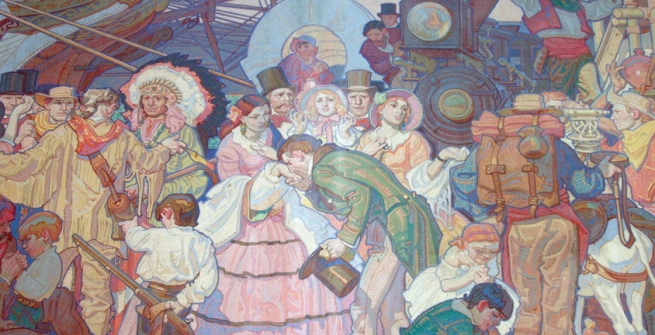One of the most breathtaking stops on our daily Docent-led Art and Architecture Tours is the majestic Grand Rotunda, encircled by the pastel-toned murals by Dean Cornwell. Eighty years after their unveiling, the 12 panels of scenes from California history still feel modern. But when the murals went up in 1933, art critics were highly critical of both Cornwell and his work. Who was the man behind these murals, and why did he provoke such harsh reviews?
American artist Dean Cornwell got his start as a graphic artist working for newspapers in the midwest in 1911. He soon moved to New York to study at the Art Students League and launched a successful career as an illustrator. His work regularly appeared on the pages of “Cosmopolitan” magazine and Hearst Publications, where he illustrated works from love stories to psychological dramas.
After a decade of success creating page-size canvases for books and magazines, Cornwell decided to challenge himself and learn the art of public mural painting. The talented illustrator set off for London to study with famous muralist Frank Brangwyn.
When a juried competition for the Los Angeles Library’s Rotunda murals was announced, Cornwell joined a slate of accomplished mural artists vying for the job. Ultimately, Cornwell’s preliminary sketches and the very low bid of $50,000 won him his first major commission in this new medium. He was the only artist who designed murals that reached up to the ceiling; all the others used the wainscoting beneath the windows as a boundary to “frame” their ideas of what the murals should be.
The murals were painted on fine Belgium linen and took five years for Cornwell to complete. Most of the work was done in London in John Singer Sergeant’s former studio, after which the canvases were carefully rolled up and finished in a scene painting studio in Los Angeles.
The mural’s theme of California History was suggested by Goodhue Associates. Cornwell chose to design panels covering four areas of California history: the Era of Discovery, the Missions, Americanization (which he called ‘the arrival of the white woman’), and the Founding of the city of Los Angeles. The eight smaller panels framing the corners depict: Fire, Water, Earth, and Air; Music, Art, Native Industry, and Learning.
In a letter of congratulation sent to Cornwell on the project’s completion in 1933, the board states that his sketches were “incomparably superior” to those of other artists. But the artist may have seriously underbid the project, as he ran out of money two years before its completion and had to take on illustration work to finish.
While the murals were in progress, Cornwell went out of his way to cultivate publicity and was able to attract an astounding number of positive articles about himself and his library mural project. But when the murals were unveiled, serious art writers took issue with both Cornwell’s commercial style and his relentless showboating.
The Los Angeles Times critic, Arthur Millier, wrote: “His attitude is not that of the greatest artists. Cornwell sees California history as a staged pageant. The people are actors, their costumes probably authentic enough, but they are scarcely people who really landed or crossed the plains to found the state and city. It is the viewpoint of the brilliant illustrator painting for romantically-minded readers of the decorative artist concerned with shapes, colors, and costumes. The lacking element is the ability to get under the costumes and make great art by presenting the simple truth of the pioneers, padres, and Indians.”
Thomas Craven, one of the most influential art critics in the country, writing in "American Mercury," was much more bluntly negative: "The most conspicuous example of monumental profanation commissioned are the enlargements of coated paper magazine illustrations with which Dean Cornwell is swiftly and inexorably ruining the interior of one of the few tolerable buildings in Los Angeles."
But times and tastes change. Today, Cornwell’s Central Library murals are counted among the city’s treasures. The negative press reception is long forgotten, and Cornwell’s library murals are counted among his best work.
Want to learn more about the historic Central Library? Please join us for a docent-led tour of the Central Library.
